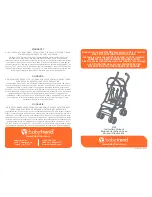
Type 310A
10
Pilot Adjustment
The second-stage working regulator must be set to
operate at a lower pressure than the monitoring pilot
or the monitoring pilot will try to take control of the
distribution pressure. Follow the steps listed to obtain
the desired results.
1. Increase the setting of the monitoring pilot by
loosening the locknut (key 4, Figure 9) and turning
the adjusting screw (key 3, Figure 9) clockwise
(into the spring case cap, key 2, Figure 9) until the
working pilot is in control of the intermediate
pressure and the second-stage working regulator
is in control of the distribution pressure.
2. Adjust the setting of the working pilot by loosening
the jam nut and turning the adjusting screw
clockwise (into the spring case cap) to increase
the intermediate pressure, or counterclockwise
(out of the spring case cap) to reduce the
intermediate pressure. Adjust until desired
intermediate pressure is reached.
3. Adjust the second-stage working regulator to
the desired distribution pressure by following
instructions for that particular regulator.
4. Adjust the setting of the monitoring pilot to
establish the desired emergency distribution
pressure, which is to be maintained in the event
of failure of the second-stage working regulator.
The steps followed may vary with each piping
situation. The basic method remains the same.
The following procedure serves as an example which
can be used or modified to make monitoring pilot
adjustments in any installation.
Increase the outlet pressure setting of the second-stage
working regulator until the monitoring pilot takes control
of the distribution pressure. Adjust the monitoring pilot
setting until the desired emergency distribution pressure
is achieved. Refer to Table 2 for the recommended
minimum differential between the monitoring pilot
setting and the desired distribution pressure.
With settings as desired on both the monitoring and
the working pilots, tighten the locknuts (key 4, Figure 9)
to maintain proper adjustment screw positions. Then
re-adjust the second-stage working regulator to the
desired distribution pressure.
Shutdown
In any installation it is important to slowly open and
close the valves and to vent the outlet pressure before
venting the inlet pressure to prevent damage caused
by reverse pressurization of the pilot or main valve.
Single-Pilot Regulators and Wide-Open
Monitor Regulators
As well as applying to a single-pilot regulator (Figure 6),
the steps in this procedure also are valid for a wide-open
monitoring installation (Figure 7) and should be repeated
for each regulator in such an installation.
1. Close the upstream isolating valve.
2. Close block valve A (Figure 6) in the supply line.
3. Close the downstream isolating valve.
4.
If the downstream control line taps into the
pipeline above the downstream isolating
valve,
open vent valve C between the regulator
and the downstream isolating valve. Permit all
pressure to bleed out of the regulator.
If the downstream control line taps into the
pipeline below the downstream isolating valve,
close hand valve B. Then open vent valve C and
vent valve D, permitting all pressure to bleed out of
the regulator.
5. Open vent valve E to release any inlet pressure
that may be trapped in the regulator.
Working Monitor Regulators
1. Close the upstream isolating valve.
2. Close hand valve in pilot supply line.
3. Close the downstream isolating valve.
4. Open a bleed valve between the second-stage
working regulator and the downstream isolating
valve. Permit all pressure to bleed out of the
working monitor regulator and the second-stage
working regulator.
5. Open vent valve to vent any intermediate pressure
trapped in the system.
6. Open vent valve to release any inlet pressure
trapped in the regulator.
Maintenance
The regulator parts are subject to normal wear
and must be inspected periodically and replaced
as necessary. The frequency of inspection and
replacement depends on the severity of service






































